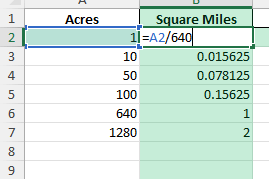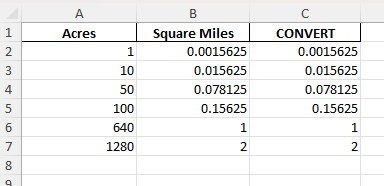When working with land measurements, especially in real estate, farming, or geography, you may need to convert values from square acres to square miles. Excel makes this task simple with direct formulas and built-in functions. In this guide, we will show step-by-step how to perform these conversions, highlight common mistakes, and provide advanced options for automating the process.
Key Takeaways
- 1 square mile equals 640 acres, which is the conversion factor.
- Excel formulas like
=A2/640can convert acres to square miles directly. - The
CONVERTfunction can perform unit conversions with=CONVERT(A2,"ac","mi2"). - Excel can generate multiple conversions quickly by filling formulas across rows.
- Advanced methods using VBA or Power Query can automate large-scale conversions.
Table of Contents
About Converting Acres to Square Miles
An acre is a common unit of land measurement, while a square mile is often used in geographic and large-scale land analysis. Since 1 square mile equals 640 acres, you can divide the number of acres by 640 to convert to square miles. Excel’s flexibility allows you to apply this calculation to single cells, entire ranges, or even automated workflows.
Step-by-Step: Convert Acres to Square Miles in Excel
Step 1: Input Acre Values
Start by entering acre values in column A. For example:
Step 2: Apply the Formula
In column B, enter this formula:
=A2/640This divides the acres in cell A2 by 640 to get square miles.
Step 3: Use the CONVERT Function
Excel also supports direct conversions using the CONVERT function:
=CONVERT(A2,"uk_acre","mi2")This gives the same result but is more descriptive for unit-based conversions.
Step 4: Copy the Formula
Drag the formula down to convert multiple acre values into square miles quickly.
Common Mistakes and How to Fix Them
Using incorrect conversion factors: Always remember that 1 square mile = 640 acres.
Typing the wrong unit codes in CONVERT: Use "ac" for acres and "mi2" for square miles.
Overwriting formulas with values: Be careful when copying results to avoid replacing formulas unintentionally.
Not applying consistent formatting: Standardize decimal places for clarity in reports.
Bonus Tips and Advanced Scenarios
Automate with VBA: Use a macro to convert entire columns automatically.
Sub ConvertAcresToMiles()
Dim rng As Range
For Each rng In Selection
rng.Offset(0, 1).Value = rng.Value / 640
Next rng
End Sub
Power Query: Import large datasets and add a calculated column dividing acres by 640.
Reverse Conversion: Multiply square miles by 640 to return to acres.
Conditional Formatting: Highlight very large land areas (e.g., over 10 sq miles) for easy visibility.
Combine with Maps: Export results into mapping tools for geographic analysis.
Use Cases for Converting Acres to Square Miles
Converting acres into square miles is useful in a wide range of professional and educational contexts. Since Excel can handle these conversions quickly and accurately, it becomes a reliable tool for analysis, reporting, and planning. Below are expanded use cases where this conversion proves valuable.
1) Real Estate
Context: Real estate professionals often need to present property sizes in a way that is easy for potential buyers and investors to understand. Small plots may be listed in acres, but large estates, ranches, or development projects are often clearer when expressed in square miles.
How to use in Excel:
Input acre values into a worksheet and apply =A2/640 or =CONVERT(A2,"ac","mi2") to calculate square miles.
Create side-by-side comparisons of properties in both acres and square miles for presentations.
Apply conditional formatting to highlight very large properties, making them stand out in reports.
Benefits:
Makes property data more accessible to investors unfamiliar with acres.
Provides a standardized way to compare land parcels of different sizes.
Improves marketing materials and investor pitch documents.
2) Agriculture
Context: Farmers and agricultural analysts need to compare farm sizes across regions. While acres are common in local contexts, square miles are better suited for large-scale regional or national comparisons.
How to use in Excel:
Convert farm acreage into square miles to compare productivity across larger land areas.
Combine conversion formulas with yield data to calculate production efficiency per square mile.
Visualize results in charts to see which regions manage larger farming operations.
Benefits:
Allows cross-region or international comparisons with consistent units.
Helps policymakers and researchers understand large-scale land use trends.
Supports decision-making for scaling farm operations or land purchases.
3) Government Reports
Context: Government agencies often publish land use, zoning, or census reports that must use standardized units for accuracy and consistency. Converting acres into square miles ensures that all stakeholders use a common reference point.
How to use in Excel:
Aggregate data from multiple counties or regions and convert all acre-based figures into square miles.
Use PivotTables to summarize land data at national, state, or local levels.
Prepare clean and consistent tables for official publications or audits.
Benefits:
Maintains consistency across official documents and datasets.
Improves comparability across different regions and reporting systems.
Reduces confusion when reports are shared with international partners or agencies.
4) Geographic Analysis
Context: Geographers and GIS analysts often work with land area data from surveys or mapping software. Excel can serve as a quick conversion tool before exporting data to specialized systems.
How to use in Excel:
Import area measurements from surveys into Excel and apply conversion formulas.
Prepare summary tables that list both acres and square miles before uploading to mapping tools.
Use Excel charts to visualize land area distributions across regions.
Benefits:
Provides a fast pre-processing step for datasets before GIS analysis.
Improves accuracy when comparing datasets that originally use different units.
Supports cleaner, more professional presentations in academic or commercial projects.
5) Education
Context: Teachers and trainers often use Excel to demonstrate real-world math applications. Converting acres into square miles provides a practical example for students learning about unit conversions, ratios, and applied mathematics.
How to use in Excel:
Provide students with a dataset of acre values and ask them to convert to square miles using formulas.
Introduce both direct formulas (=A2/640) and the CONVERT function to show alternative approaches.
Create exercises where students must identify errors, such as using the wrong conversion factor.
Benefits:
Engages students with practical, real-world examples of Excel applications.
Reinforces understanding of math and unit conversion concepts.
Builds confidence in using Excel for both academic and professional problem-solving.
FAQ
How many acres are in a square mile?
There are 640 acres in one square mile.
What formula should I use in Excel?
Divide acres by 640, e.g., =A2/640.
Can I use Excel’s CONVERT function?
Yes, use =CONVERT(A2,"ac","mi2") for direct conversion.
Does Excel support reverse conversion?
Yes, use =CONVERT(A2,"mi2","ac") or multiply by 640.
How do I avoid errors in large datasets?
Use consistent formulas and consider Power Query for automated transformations.
John Michaloudis is a former accountant and finance analyst at General Electric, a Microsoft MVP since 2020, an Amazon #1 bestselling author of 4 Microsoft Excel books and teacher of Microsoft Excel & Office over at his flagship MyExcelOnline Academy Online Course.











